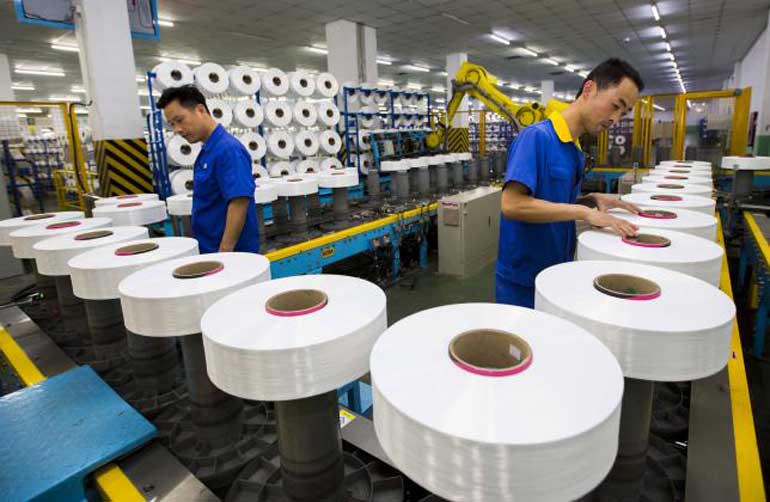Friday Feb 21, 2025
Friday Feb 21, 2025
Thursday, 13 August 2015 00:00 - - {{hitsCtrl.values.hits}}
 Employees work along a production line of a textile factory in Suzhou, Jiangsu province, China – REUTERS
Employees work along a production line of a textile factory in Suzhou, Jiangsu province, China – REUTERS
Reuters: Growth in China’s factory output, investment and retail sales were all weaker than expected in July, adding pressure on Beijing to roll out more measures to prevent a deeper slowdown, days after it shocked markets by devaluing its currency.
While the central bank insisted on Wednesday it would not let the yuan slide too far, the devaluation came days after data showed a hefty drop in exports and producer prices, which clearly weighed on Chinese manufacturers last month.
Nearly all data released for July was weaker than economists had forecast, pointing to further deterioration in the world’s second-largest economy. Data for June had fueled some hopes that activity was stabilising after policymakers unleashed the biggest burst of stimulus since the global financial crisis.
Factory output rose 6.0% in July from a year earlier, slowing from June’s 6.8% rise and hitting a three-month low. Economists had expected a 6.6% rise.
Fixed-asset investment, a crucial driver of the world’s second-largest economy, also disappointed, rising 11.2% in the first seven months compared with the year-ago period, the weakest pace in nearly 15 years, the National Bureau of Statistics showed on Wednesday.
Markets had expected an 11.5% rise, which would have been a slight improvement from June and put the outlook for the second-half of the year on somewhat more solid footing.
Property investment growth cooled to 4.3%, the weakest since March 2009, despite a pick-up in housing sales.
The investment figure is being closely watched as the government tries to quicken infrastructure spending to shore up growth.
Retail sales rose 10.5% in July from the same time last year, slightly below forecasts for 10.6% growth, which would have been even with June’s reading. Auto sales fell 7.1% even as carmakers slashed prices and offered sweeter incentives.
The sluggish activity figures followed disappointing trade and inflation readings earlier this month that showed persistent weakness in the economy despite repeated stimulus measures.
The central bank has repeatedly cut interest rates and banks’ reserve requirement to boost credit and lower borrowing costs, and further policy easing is widely expected to avert a sharper slowdown.
If conditions do not improve soon, growth could fall below 6.5% in the current quarter, from 7% in the second quarter, ANZ economists said in a note.
Some economists believe China’s economy is already growing only half as fast as official data shows, or even less.
Discover Kapruka, the leading online shopping platform in Sri Lanka, where you can conveniently send Gifts and Flowers to your loved ones for any event including Valentine ’s Day. Explore a wide range of popular Shopping Categories on Kapruka, including Toys, Groceries, Electronics, Birthday Cakes, Fruits, Chocolates, Flower Bouquets, Clothing, Watches, Lingerie, Gift Sets and Jewellery. Also if you’re interested in selling with Kapruka, Partner Central by Kapruka is the best solution to start with. Moreover, through Kapruka Global Shop, you can also enjoy the convenience of purchasing products from renowned platforms like Amazon and eBay and have them delivered to Sri Lanka.
Discover Kapruka, the leading online shopping platform in Sri Lanka, where you can conveniently send Gifts and Flowers to your loved ones for any event including Valentine ’s Day. Explore a wide range of popular Shopping Categories on Kapruka, including Toys, Groceries, Electronics, Birthday Cakes, Fruits, Chocolates, Flower Bouquets, Clothing, Watches, Lingerie, Gift Sets and Jewellery. Also if you’re interested in selling with Kapruka, Partner Central by Kapruka is the best solution to start with. Moreover, through Kapruka Global Shop, you can also enjoy the convenience of purchasing products from renowned platforms like Amazon and eBay and have them delivered to Sri Lanka.